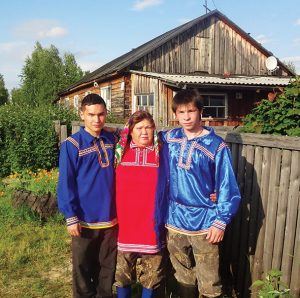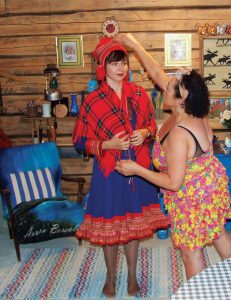Ildikó Tamás, linguist, folklorist, ethnologist, Budapest, Hungary
Several people have dealt with the analysis and description of the connection between text and melody in Hungarian folk song, from Zoltán Kodály to the ethnomusicologist Lajos Vargyas and the linguist-philologist László Dezső. Nevertheless, the topic hardly appears in the 21st-century’s research topics in Hungary.

First I will summarize the research results of Hungarian prosody for the sake of comparison in my article. Then I will describe the similarities and differences in the use of possibilities inherent in prosody in the case of different cultures, using the example of nearly and distantly related people. Languages that belong to the same linguistic family have similar prosody features. This influence appears in the singing tradition, so alongside Hungarian, Khanty1, and Sámi2, we could also add Finnish, Estonian, Mordvin, and other examples with similar features (for example: Sebeok 1952, Hajdú 1982). Of course, specific examples only allow for a relative comparison because – in contrast to strophic folk songs with a fixed structure, mostly sung with a constant number of syllables – the basis of Sámi musical thinking, for example, is the melody with a more flexible, motivic structure. A slightly closer analogy to the Hungarian phenomenon is the prosodic toolkit of Khanty individual songs that we know about from the studies of W. Steinitz, R. Austerlitz, Éva Schmidt, and Márta Csepregi. In Uralic linguistics, there is a well-known tradition of research on verse syntax that can serve as a lesson in musical studies (for example, Steinitz 1934, Austerlitz 1958, Lotz 1960). In addition to the musical approach, I also use the linguistic interpretation of prosody in my article. In languages, as well as in text, suprasegmental tools (tone, pitch, stress, pause, etc.) are involved in shaping what is said; the latter can occasionally modify the meaning conveyed by the words. This aspect plays a particularly important role in melodies with an informal structure close to speech.
It is a general characteristic of Hungarian singing that in genres close to speech both the accentuation conditions as well as the intonation of sentences reflect natural speech. For example, the melody line of the lamenter can be matched to the line of the lamenting speech melody, i.e. it describes a descending line (Szomjas-Schiffert 1996: 36–43). The upward melodic closure creates a feeling of incompleteness in Hungarian. Reciting melodies that rhythmically depict speech is close to informal singing. The instinctive musical use of suprasegmental tools is also well exemplified by our work rhymes, in which it is unthinkable that the emphasis of speech and melody are not in harmony. According to Antal Békefi, the rhythm increases the pace of the work, and the upward pitch jump represents the peak of the effort. Furthermore, the use of greater force is achieved by thickening the rhythm (Békefi 2005: 44–45).

Hungarian children’s rhymes and playing songs are quite different from this phenomenon. The rhythm takes precedence in their structure of pairs of beats or motifs. Therefore, the emphasis and segments of the text are often shifted which can also make it difficult to understand the content.
In strophic folk songs, despite the solid rhythmic structure, one can observe the effort to harmonize small details of melody and text. The adaptive scoring indicates this in the Hungarian singer’s performance. In this regard, János Bereczky puts it as follows: “The Hungarian people […] also sing eighths with a certain internal flexibility, one might say with small punctuation, clearly and exclusively depending on the shortness and length of text syllables. It was created by the same unified sense of language […]” (Bereczky 2003: 448). In addition, as Lajos Vargyas points out: “the rubato, i.e. free, changing rhythm, is in principle adapted to the text. However, this is not always the case: precisely because the rhythm is free, because it does not confine the language to strictly measured time limits, it does not even have to follow the length relationships and accents of the language. That is why musical requirements prevail. Variety, highlighting, and lengthening certain places, climaxes, or stops of the melody line; where rich ornamentation surrounds the melody, the individual melisma groups do not always extend the notes according to the syllable length with dividing a phrase according to its musical needs. It (rarely) happens that they suppress requirements of the language for the sake of a rhythmic turn, […] for the sake of some musical effect” (Vargyas).
Even in the Ob-Ugric singing tradition, there are strict rules for the correct coordination of fine details of text and melody. Katalin Lázár noticed that the division of musical units often does not match that of textual units (Lázár 1987; Lázár – Sipos 2008). However, half-line shifts of the text in Khanty songs cannot completely overturn the accentuation conditions. Éva Schmidt invested a lot of time and energy in mapping out the prosody of Khanty songs. She found that “a very complicated toolkit – mainly the filler syllables – ensures that the accents belonging to the musical, linguistic, and metrical levels are coordinated. The location of filler syllables is far from accidental or imaginative” (cited by: Lázár – Sipos 2008: 13). Her opinion is consistent with the results of previous similar research (see Steinitz 1934; Austerlitz 1958; Lotz 1960). Of course, we could list similar examples at length, the comparison of which provides many parallels with the Hungarian material. Prosodic features are among the most durable phenomena of languages. It demonstrates the well-known fact that all Uralic languages have fixed (first syllable) stress, even if their other features have developed over the millennia. This fixed emphasis prevails in the singing folklore of peoples belonging to the Uralic language family, as documented by the best-examined Hungarian and Khanty material.
 A prosodic phenomenon different from the ones presented so far is found among the Finno-Ugric-speaking peoples in the Sámi singing tradition. The special feature of their folk songs, the yoiks, is that they hardly contain any meaningful text: mainly nonsense words of one or two syllables sung to the melody. According to the Sámi writer and poet Nils-Aslak Valkeapää, not only the independent semantic value of the words but also the prosodic construction itself is involved in the transmission of the message in yoik texts. The grammatically and semantically uninterpretable elements that make up the majority of the text blocks – e.g. valla-valla, vaja haja, lai le, loilo, loilá, lolai, loo, lolloloo, lul-luu, reiun loilo, na, nuu-nuu nunnu, njollo… – are probably intended to promote the continuity of the music. These syllables form the pure basis of musical structure (Valkeapää 1984). Valkeapää’s explanation of the use of text blocks also includes, albeit tangentially, statements related to prosody, although he only talks about the continuity of music and not about correct rhythmicity in this context. The Sámi yoik often disregards the emphasis requirements of the language, since the musically and rhythmically stressed sounds do not fit the stressed places of natural speech while at the same time a syllable that is otherwise unstressed in natural speech comes out for a longer sustained or emphatic vocal sound (Tamás 2001: 302–303). With the frequent use of filler elements – if we start from the singing practice of other Finno-Ugric peoples – it would be possible to adjust the meaningful text passages in the song to the right place in terms of emphasis. The Khanty singers do not operate with rhythm either – although correct prosody is important to them. Instead, they shape (add or shorten) the text to achieve good stress distribution. This is not what happens in yoik singing, on the contrary: nonsense words supplementing a meaningful text rarely serve the metrical balance or the coordination of accents. This phenomenon can be considered an important characteristic of the Sámi performance style, in which perhaps the intentional weakening of text, maintaining the audience’s attention, playfulness, and the performer’s prowess may also play a role. The function of prosodic shifts of yoiks can be similar to the shift of line structure found in Khanty’s performance. According to Katalin Lázár, the different, intersecting structure of text and melody creates tension and is a means of “ending” the song, which “requires a concentration that lifts both the performer and the listener out of everyday reality” (Lázár 1987: 217). In the case of Khanty “the purpose of this editing method is not only to make the sometimes hundreds of lines of songs enjoyable and varied but also to create and maintain the emotional state necessary for both the performance and reception” (Lázár 1987: 217). Similar motivations can be at work in the case of Sámi yoik singers.
A prosodic phenomenon different from the ones presented so far is found among the Finno-Ugric-speaking peoples in the Sámi singing tradition. The special feature of their folk songs, the yoiks, is that they hardly contain any meaningful text: mainly nonsense words of one or two syllables sung to the melody. According to the Sámi writer and poet Nils-Aslak Valkeapää, not only the independent semantic value of the words but also the prosodic construction itself is involved in the transmission of the message in yoik texts. The grammatically and semantically uninterpretable elements that make up the majority of the text blocks – e.g. valla-valla, vaja haja, lai le, loilo, loilá, lolai, loo, lolloloo, lul-luu, reiun loilo, na, nuu-nuu nunnu, njollo… – are probably intended to promote the continuity of the music. These syllables form the pure basis of musical structure (Valkeapää 1984). Valkeapää’s explanation of the use of text blocks also includes, albeit tangentially, statements related to prosody, although he only talks about the continuity of music and not about correct rhythmicity in this context. The Sámi yoik often disregards the emphasis requirements of the language, since the musically and rhythmically stressed sounds do not fit the stressed places of natural speech while at the same time a syllable that is otherwise unstressed in natural speech comes out for a longer sustained or emphatic vocal sound (Tamás 2001: 302–303). With the frequent use of filler elements – if we start from the singing practice of other Finno-Ugric peoples – it would be possible to adjust the meaningful text passages in the song to the right place in terms of emphasis. The Khanty singers do not operate with rhythm either – although correct prosody is important to them. Instead, they shape (add or shorten) the text to achieve good stress distribution. This is not what happens in yoik singing, on the contrary: nonsense words supplementing a meaningful text rarely serve the metrical balance or the coordination of accents. This phenomenon can be considered an important characteristic of the Sámi performance style, in which perhaps the intentional weakening of text, maintaining the audience’s attention, playfulness, and the performer’s prowess may also play a role. The function of prosodic shifts of yoiks can be similar to the shift of line structure found in Khanty’s performance. According to Katalin Lázár, the different, intersecting structure of text and melody creates tension and is a means of “ending” the song, which “requires a concentration that lifts both the performer and the listener out of everyday reality” (Lázár 1987: 217). In the case of Khanty “the purpose of this editing method is not only to make the sometimes hundreds of lines of songs enjoyable and varied but also to create and maintain the emotional state necessary for both the performance and reception” (Lázár 1987: 217). Similar motivations can be at work in the case of Sámi yoik singers.
Therefore in the dialectic of the interaction of text and melody similar and contradictory tendencies can be observed, even among speakers of related languages. I have illustrated this, in a nutshell, using the example of Hungarian, Ob-Ugric, and Sámi singing traditions.
 Ildikó, Tamás PhD, linguist, folklorist, ethnologist. She works as a senior research fellow at the Institute of Ethnology (Research Centre for the Humanities, Eötvös Loránd Research Network, Budapest). Her research fields are Sámi languages and folklore, interdisciplinary study of Sámi yoiks, „nonsense” texts in folklore, prosodic and etymological studies, children’s folklore, and online folklore. Her selected works in English linking to the present paper are: The Voice of the Devil (?) The Sami Song in the “Cross”-fire of Various Discourses, In Bea, Vidacs; Éva, Pócs (eds.) Faith, Knowledge, and Doubt in Religious Thinking, Balassi Kiadó (2020); Tamás Ildikó: Field, data, access. Fieldwork among the Sámi from the perspective of assimilation and ethnic revitalization processes, Acta Ethnographica Hungarica 63, 2018; Tamás Ildikó: The Colours of the Polar Lights: Symbols in the Construction of Sami Identity, In Szilárd, Tibor; Tóth, Roza; Kirillova, Jüva Sullõv (eds.) Vabahuso moistoq Hummogu-Euruupa kirändüisin. Vabaduse Konsept Ida-Euroopa kirjandustes. The concept of freedom in the literatures of Eastern Europe, Voro Instituudi Toimondusoq (2017); Tamás Ildikó: “Few words are sung in it” Questions of Methodology in Studying Sami Yoik Texts, In Kajsa, Andersson (ed.) L’Image du Sápmi III., Humanistic Studies at Örebro University (2013). Email: tamas.ildiko11@gmail.com
Ildikó, Tamás PhD, linguist, folklorist, ethnologist. She works as a senior research fellow at the Institute of Ethnology (Research Centre for the Humanities, Eötvös Loránd Research Network, Budapest). Her research fields are Sámi languages and folklore, interdisciplinary study of Sámi yoiks, „nonsense” texts in folklore, prosodic and etymological studies, children’s folklore, and online folklore. Her selected works in English linking to the present paper are: The Voice of the Devil (?) The Sami Song in the “Cross”-fire of Various Discourses, In Bea, Vidacs; Éva, Pócs (eds.) Faith, Knowledge, and Doubt in Religious Thinking, Balassi Kiadó (2020); Tamás Ildikó: Field, data, access. Fieldwork among the Sámi from the perspective of assimilation and ethnic revitalization processes, Acta Ethnographica Hungarica 63, 2018; Tamás Ildikó: The Colours of the Polar Lights: Symbols in the Construction of Sami Identity, In Szilárd, Tibor; Tóth, Roza; Kirillova, Jüva Sullõv (eds.) Vabahuso moistoq Hummogu-Euruupa kirändüisin. Vabaduse Konsept Ida-Euroopa kirjandustes. The concept of freedom in the literatures of Eastern Europe, Voro Instituudi Toimondusoq (2017); Tamás Ildikó: “Few words are sung in it” Questions of Methodology in Studying Sami Yoik Texts, In Kajsa, Andersson (ed.) L’Image du Sápmi III., Humanistic Studies at Örebro University (2013). Email: tamas.ildiko11@gmail.com
Edited by Rebeka Angstmann, UK
Bibliography
- Austerlitz, Robert (1958), Ob-Ugric Metrics. Kn. Helsinki.
- Lotz, János (1960), Kamassian Verse. Journal of American Folklore.
- Sebeok, Thomas A. (1952), Studies in Cheremis folklore. Indiana University, Bloomington.
- Steinitz, Wolfgang (1934), Der Parallelismus in der finnisch-karelischen Volksdichtung. Helsinki.
Databases
1 Khanty people are the indigenous people of North-Western Siberia (Russia), around the Ob, Irish and Ishim rivers with their tributaries. Estimated total population: 28-30 thousand people.
2 Sámi people are the indigenous people of Northern Scandinavia. Most of them live in Norway, Finland and Sweden. Some thousands live in Russia. Estimated total population: 100-150 thousand people.

